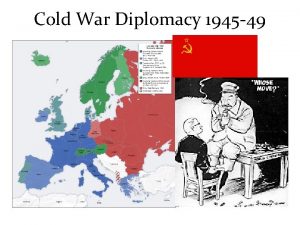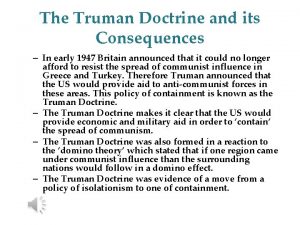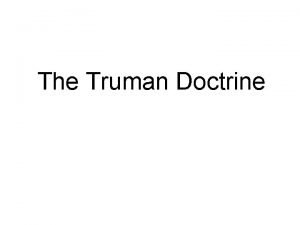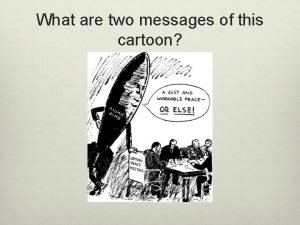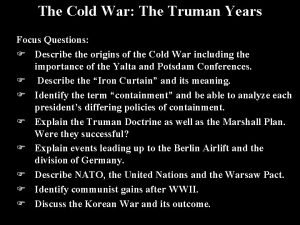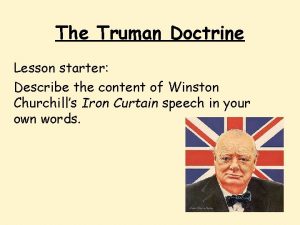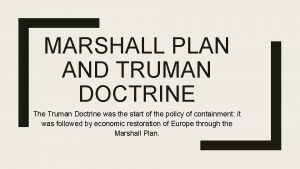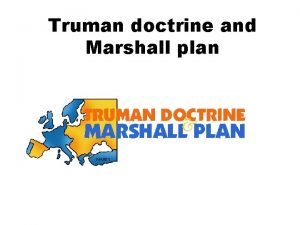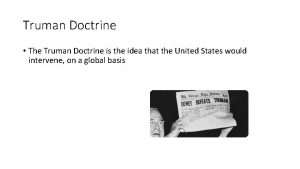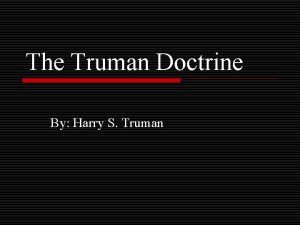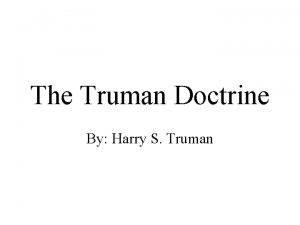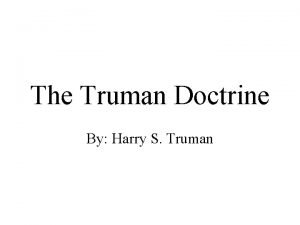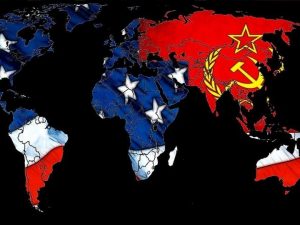The Truman Doctrine and its Consequences In early








- Slides: 8

The Truman Doctrine and its Consequences – In early 1947 Britain announced that it could no longer afford to resist the spread of communist influence in Greece and Turkey. Therefore Truman announced that the US would provide aid to anti-communist forces in these areas. This policy of containment is known as the Truman Doctrine. – The Truman Doctrine makes it clear that the US would provide economic and military aid in order to ‘contain’ the spread of communism. – The Truman Doctrine was also formed in a reaction to the ‘domino theory’ which stated that if one region came under communist influence than the surrounding nations would follow in a domino effect. – The Truman Doctrine was evidence of a move from a policy of isolationism to one of containment.

Some of the consequences of the Truman Doctrine were: – The creation of the Marshall Plan: This plan offered American economic aid to any European nation. This was based on the ideas that it would make the idea of capitalism more attractive than communism, and that this could combat communism since poverty increased the appeal of communism. – That it ensured that there would be a policy of ‘collective security’ and NATO was established: The NATO alliance was a diplomatic and military form of containment which promised that member countries would help one another if they were ever threatened. – It inflamed the tensions of the Cold War. – (American) NSC 68 Policy for massive arms spending and military aid to anticommunist groups: This was an example of the arms race and military containment. – It became the justification for American intervention to prevent communist victories in other countries: The need to justify to economic cost of containment led to US presidents over dramatising the Soviet threat; the Americans saw the need for an unprecedented peacetime military build up which helped to contribute to the arms race; and the US found themselves propping up corrupt dictatorships just because they were anti communist. – The USSR retaliated by: Rejecting the Marshall Aid and refused to let their satellite states participate in the Marshall Plan, they also set up COMECON which was designed to give economic aid to communist countries in Eastern Europe.

• • • The Truman Doctrine and its consequences: Between 1945 and 1948, a number of Eastern European controls came under the influence of the Soviet Union. Yugoslavia, Albania, Bulgaria, Romania, Hungary, Poland East Germany and Czechoslovakia all became communist and ‘satellite states’ of the USSR. With the exception of Yugoslavia and Albania, these states all became communists in very similar ways. Firstly, the local communist party would form coalition governments with other parties and take control of key parts of the government. The outmaneuvered their coalition partners and eventually banned all political opposition. Communism also made gains in Western Europe, where extreme poverty and hardship drove people towards them. The French elections of 1946 had almost a third of voters support the French communist party. The great gains that the Soviet Union received increased the tension with the US, who became more hostile against them. In February 1946, an official in the US embassy in Moscow recommended a response to Soviet expansion. This response was known as the ‘containment policy, where Soviet influence would be confined to the areas they already dominated.

• • During WW 2 and afterwards, Greece was in civil war when the communist group ELAS attempted to seize control of the country. Britain sent troops to aid against ELAS. Turkey was also under threat of communism in 1956, when the Soviets applied pressure on them for the return of disputed territory. Britain also sent troops to Turkey to keep it from communist revolution as Turkey was seen in the West as a vital country for its close proximity to the oil fields in the Middle East. In 1947, Britain was near collapse and put the responsibility of Greece and Turkey to the US. As a result, Truman implemented the Truman Doctrine – the official adoption of the containment policy. The Truman Doctrine would dominate US foreign policy for decades, and meant that the US would spend its resources to stop the spread of communism. As a result, the US would spend billions of dollars and resources including men, to stop the spread of communism in Korea, Vietnam, and other places. In June 1947, US secretary of State, George Marshall announced the Marshall plan, the economic side of the Truman Doctrine. The Marshall plan would send aid to the devastated economies of Europe to try and reestablish support for capitalism. Between 1948 and 1951, the US would send $20 billion of aid into Europe. The Soviet Union responded to this, fearing that the Marshall plan would undermine communist influence. As a result, the Communist Information Bureau (Cominform) and the Council for Mutual Economic Assistance (Comecon) were set up.

Activity for Comprehension and Revision 1945 conferences: Complete following summary Name: Yalta Conference Date: 4 th to the 11 th February 1945 People: Who attended? Discussed: What was discussed? Resolved: What was resolved? Impact: What was the impact on the Cold War? How did it change Truman’s approach to the Cold War?

Potsdam Conference Worksheet Name: Potsdam Conference – held in Germany Date: 17 th of July to 2 nd August 1945 People: Who attended? Discussed: What was discussed? Resolved: What was resolved at the Conference? Impact: What was the impact on the Cold War?

Truman Doctrine What was the Truman Doctrine? What was its connection to NCS 68? What was the Marshall Plan? How did this reflect US ideology? How did the USSR respond? What was the impact on the Cold War?

If you completed the two summary sheets and would like to have an answer summary sent through email Mrs Hetherington on khetherington@ncs. nsw. edu. au Send through your work and I will send through comments and completed worksheet answers.
